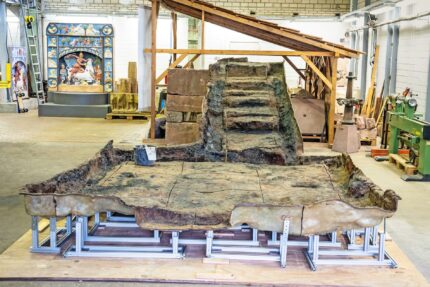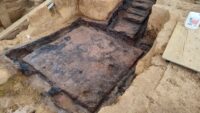 A Roman wooden cellar complete with five-step staircase in an exceptional state of preservation has been discovered in Frankfurt and recovered. Dating to the late 1st century, the cellar is all that remains of a half-timbered Roman residential building which burned down in a fire. Roman cellars were not like basements today, but rather underground storage rooms formed by beams along the sides and boards on the floor. The beams and boards survived the millennia because they were carbonized by the flames.
A Roman wooden cellar complete with five-step staircase in an exceptional state of preservation has been discovered in Frankfurt and recovered. Dating to the late 1st century, the cellar is all that remains of a half-timbered Roman residential building which burned down in a fire. Roman cellars were not like basements today, but rather underground storage rooms formed by beams along the sides and boards on the floor. The beams and boards survived the millennia because they were carbonized by the flames.
The cellar was unearthed by a team from the Frankfurt Monuments Office in the Heddernheim district of northwest Frankfurt, in March of 2023. Founded as a civilian settlement attached to a series of fortresses established by Augustus during his German campaigns, modern-day Heddernheim was the ancient city of Nida. It was made the capital of the Civitas Taunensium area by the emperor Trajan in In 110 A.D. and at its peak had a population of 10,000. It was gradually abandoned starting around 260 A.D. under pressure from the invading Alemanni confederation. Its ruins above ground were visible until the 15th century when they were pillaged for construction materials. Most of the underground remains were all but destroyed during real estate developments in the 20th century.
 Few structures from ancient Nida have been found in excavations, and while the remains of wooden cellars have been found over the past century, they were not well-preserved and the technology to conserve and study them didn’t exist then. This cellar’s size and preservation are so extraordinary it is the best preserved remnant of the ancient city. It will give researchers a unique opportunity to learn about Roman Nida.
Few structures from ancient Nida have been found in excavations, and while the remains of wooden cellars have been found over the past century, they were not well-preserved and the technology to conserve and study them didn’t exist then. This cellar’s size and preservation are so extraordinary it is the best preserved remnant of the ancient city. It will give researchers a unique opportunity to learn about Roman Nida.
![]() As soon as it was exposed to the elements, the cellar was in danger, so the floor, side beams and staircase were removed in a complex operation. The whole kit and caboodle weighed 50-60 tons, so it could not be raised whole, and as soon as any part of the soil around it dried out, the wood could have cracked. The team took an innovative approach. First they sprayed on a layer of synthetic resin, then a separating layer of silicone rubber and a final top layer of plaster to fix the surface. The cellar was then cut into 33 blocks to transport them to the restoration workshop of the Archaeological Museum Frankfurt.
As soon as it was exposed to the elements, the cellar was in danger, so the floor, side beams and staircase were removed in a complex operation. The whole kit and caboodle weighed 50-60 tons, so it could not be raised whole, and as soon as any part of the soil around it dried out, the wood could have cracked. The team took an innovative approach. First they sprayed on a layer of synthetic resin, then a separating layer of silicone rubber and a final top layer of plaster to fix the surface. The cellar was then cut into 33 blocks to transport them to the restoration workshop of the Archaeological Museum Frankfurt.
 At the museum, restorers removed the soil from the back and underside of the wood and reinforced the base with fiberglass. This was the first time this technique has been used. The conserved cellar was shown to the press, but there are no plans to put it on public display. Museum officials would prefer to return it to its original context, but it is a building plot privately owned by housing developers, so they’re considering creating an archaeological park nearby where the cellar and other finds made since construction began in 2021 (hypocaust heating, pottery kilns, a public latrine) could also be displayed.
At the museum, restorers removed the soil from the back and underside of the wood and reinforced the base with fiberglass. This was the first time this technique has been used. The conserved cellar was shown to the press, but there are no plans to put it on public display. Museum officials would prefer to return it to its original context, but it is a building plot privately owned by housing developers, so they’re considering creating an archaeological park nearby where the cellar and other finds made since construction began in 2021 (hypocaust heating, pottery kilns, a public latrine) could also be displayed.
This German language video gives a great overview of the site and the additional finds made in the cellar.
There is a MAP of the Roman town of Nida with explanations.
As with any other Roman town in Germany and elsewhere, there is a ‘fort’ and a ‘vicus’, plus ‘villae rusticae’ in the countryside:
We have in RED the forts and military installations, i.e. the forts A–L, of which ‘fort A’ is the main one and oldest.
In BLUE, we have the ‘vicus’, i.e. the town of Nida with the two Roman roads in GREY and:
———
1= Western thermal baths
2= Praetorium
3= Eastern thermal baths
4= A little wooden theater
5= Harbor to the river Nidda
6= The (rather cryptic) “Cellar of the Dendrophores” (i.e. “wood bearers”, cf. Cybele cult), apparently not the one discussed here.
f= Forum
m= Mithras shrines
+= Roman graveyards or -fields
———
There are the Roman cities of Frankfurt and Mainz (“Mayence”) nearby. An entirely different approach of (planned) Roman urban development, however, had been the Forum of Lahnau-Waldgirmes (“Waldgirmes”).
PS: The video explains that in early Nida there were mainly wooden buildings and timbered frames, i.e. there were no stone buildings. The black area is burned wood or coal, while the red and orange is, where the fire burned the clay. There were two large amphorae for oils storage, and grain. The heat blew the vessels apart. He then describes the wood, and how the cellar was constructed, and a few things found on the stairs are presented. Objects of iron and bronze, (prints?) of an oval shoe sole, a molten glass vessel and tools. He concludes on how and where all of this potentially will end up.
“Frankonia est divisa in partes duas.” – Thus, in the West we have “WINE Frankonia” and in the East “BEER Frankonia”, with more or less the Roman ‘Rhaetian Limes’ in between. Today, the frontier has moved a bit to the east (Würzburg and the western Main valley).
Like Mithras, the cult of ‘Cybele and Attis’ was not uncommon in the Roman provinces. Like Eastern today, or an early form of it, there were ancient Roman religious festivals –the “Holy Week”– celebrated on the March equinox.
Citizens and freedmen were allowed limited forms of participation in rites pertaining to Attis, through their membership of two colleges, each dedicated to a specific task. The Cannophores (“reed bearers”) and the Dendrophores (“tree bearers”):
– March 15 (Ides): Canna intrat (“The Reed enters”).
– March 22: Arbor intrat (“The Tree enters”).
After that, on the Tubilustrium (an archaic holiday to Mars, with sacrifice of a lamb), the tree was laid to rest at the temple of the Great Mother (today, after beer festivals, we bury the Kirchweih tree or at least a barrel).
– March 24: Sanguem or Dies Sanguinis (“Day of Blood”), a frenzy of mourning when the devotees whipped themselves to sprinkle the altars and effigy of Attis with their own blood.
Of course, beer is correctly consumed from “Situlae” (oder ‘Seidla’ as they are called today), i.e. half liter stoneware. Note that only barbarians use Masskrugs!
In ‘beer frankonia’, the scapula -plus meat- of a pig is used for “Schäuferla’, while in ‘wine frankonia’ for ‘Jambon de Mayence’ (i.e. ham from wine lees, mentioned by François Rabelais in 1534, Thomas Jefferson in 1788, Charles Dickens in 1868, completely lost after WWII and rediscovered ca. 20 years ago).
French children’s song: “Un jambon de Mayen-ce, V’là qu’ça commen-ce déjà bien! Nous allons fair-re boban-ce, A ce festin il ne manquera rien car j’aperçois… Deux jambons de Mayence …(etc.)”
From the English edition of ‘Larousse gastronomique’: “Mainz ham is brined, desalted, soaked in brandy or wine lees and smoked for a long period”.